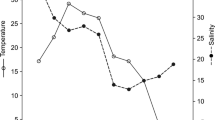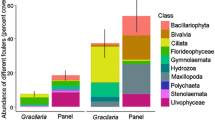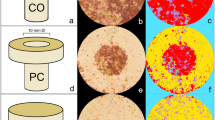Abstract
Carapace wettability and density of fouling organisms (bacteria, diatoms, protozoa, fungi, macro-organisms) were investigated for 45 crustacean species (Hoplocarida, Decapoda) from 15 families in the Gulf of Thailand. The results show that crustaceans can create and maintain characteristic carapace wettabilities. About 21 species (47%) possess highly wettable carapaces with contact angles below 20°. Contact angles between 20° and 40° were recorded for four species (2%), angles between 40° and 60° for eight species (4%) and from 60° to 70° for 11 (24%) species. One species, Alpheus euphrosyne (Alpheidae, Decapoda), exhibited an extremely low surface wettability (contact angle: 91°). Densities of colonisers and contact angles did not correlate. Very low wettability by water (θ > 90°) may only contribute little to fouling reduction in A. euphrosyne which showed the most hydrophobic carapace surface and was colonised by the lowest numbers of bacteria among all species and no other colonisers at all. We conclude that surface wettability is of little relevance for antifouling defence in crustaceans.
Similar content being viewed by others
References
Absolom, D. R., F. V. Lamberti, Z. Policova, W. Zingg, C. J. Van Oss & A. W. Neumann, 1983. Surface thermodynamics of bacterial adhesion. Apl. envir. Microbiol. 10: 90–97.
Abu, G. O., R. M. Weiner, J. Rice & R. R. ColwellL, 1991. Properties of an extracellular adhesive polymer from the marine bacterium Schewanella colwelliana. Biofouling 3: 69–84.
Baier, R. E., 1970. Surface properties influencing biological adhesion. In Manly, R. S. (ed.), Adhesion in Biological Systems. Academic Press, New York, London: 15–48.
Barnes, H. & T. B. Bagenal, 1951. Observations on Nephrops norvegica (L.) and on an epizooic population of Balanus crenatus Brug. J. mar. biol. Ass. U.K. 30: 369–380.
Bauer, R. T., 1989. Decapod crustacean grooming: functional morphology, adaptive value and phylogenetic significance. In Felgenhauer, B. E., L. Walting & A. B. Thistle (eds), Functional Morphology of Feeding and Grooming in Crustacea, Crustacean Issues 6, F. R. Schram (ed.), A. A. Balkema, Rotterdam, Brookfield: 49–74.
Becker, K., 1993. Attachment strength and colonisation pattern of two macrofouling species on substrata with different surface tension (in situ studies). Mar. Biol. 117: 301–309.
Becker, K., 1996. Epibionts on carapaces of some malacostracan crustaceans from the Gulf of Thailand. J. crust. Biol. 16: 92–104.
Becker, K. & M. Wahl, 1996. Behavioural patterns as natural antifouling mechanisms of tropical marine crabs. J. exp. mar. Biol. Ecol. 203: 245–258.
Becker, K., S. Siriratanachai & T. Hormchong, 1997. Influence of initial substratum surface tension on marine micro-and macrofouling in the Gulf of Thailand. Helgoländer. wiss. Meeresunters. 51: 445–461.
Brewer, R. H., 1984. The influence of the orientation, roughness and wettability of solid surfaces on the behaviour and attachment of planulae of Cyanea (Cnidaria: Scyphozoa). Biol. Bull. 166: 11–21.
Bultman, J. D., J. R. Griffith & D. E. Field, 1984. Fluoropolymer coatings for the marine environment. In Costlow, J. D. & R. C. Tipper (eds), Marine Corrosion and Biodeterioration-An Interdisciplinary Study. E. & F. N. Spon. Ltd., London: 237–243.
Carman, K. R. & F. C. Dobbs, 1997. Epibiotic microorganisms on copepods and other marine crustaceans. Microscopy Res. Techn. 37: 116–135.
Chamberlain, A. H. L., 1976. Algal settlement and secretion of adhesive materials. In Sharpley, J. M. & A. M. Kaplan (eds), Proc. 3rd Intern. Biodegrad. Symp., Appl. Sci., London: 417–432.
Compere, P. & G. Goffinet, 1995. Cytochemical demonstration of acid mucopolysaccharides in the epicuticular surface coat of the crab Carcinus maenas (L.) (Crustacea, Decapoda). Belg. J. Zool. 125: 95–100.
Cooksey, K. E. & B. Cooksey, 1986. Adhesion of fouling diatoms to surfaces: some biochemistry. In Evans, L. V. & K. D. Hoagland (eds), Algal Biofouling. Elsevier, Amsterdam: 41–53.
Corpe, W. A., 1980. Microbial surface components involved in adsorption onto surfaces. In Bitton, G. & K. C. Marshall (eds), Adsorption of Micro-organisms to Surfaces. Wiley Interscience Publ., New York: 105–143.
Crisp, D. J., G. Walker, G. A. Young & A. B. Yule, 1985. Adhesion and substrate choice in mussels and barnacles. J. Coll. Interf. Sci. 104: 40–50.
Decho, A. W., 1990. Microbial exopolymer secretions in ocean environments: their role(s) in the food webs and marine processes. Oceanogr. mar. Biol. Ann. Rev. 28: 73–153.
Denell, R., 1960. Integument and exoskeleton. In Waterman, T. H. (ed.), The Physiology of Crustacea, Vol. I. Academic Press, New York-London: 449–473.
Dexter, S. C., 1979. Influence of substratum critical surface tension on bacterial adhesion-In situ studies. J. Coll. Interf. Sci. 70: 346–354.
Fletcher, M. & G. I. Loeb, 1979. Influence of substratum characteristics on the attachment of a marine Pseudomonad to solid surfaces. Apl. envir. Microbiol. 37: 67–72.
Fletcher, M., J. M. Lessmann & G. I. Loeb, 1991. Bacterial surface adhesives and biofilm matrix polymers of marine and freshwater bacteria. Biofouling 4: 120–140.
Fletcher, R. L. & R. E. Baier, 1984. Influence of surface energy on the development of the green alga Enteromorpha. Mar. Biol. Lett. 5: 251–254.
Gil-Turnes, M. S., M. E. Hay & W. Fenical, 1989. Symbiotic marine bacteria defend crustacean embryos from a pathogenic fungus. Science 240: 116–118.
Gili, J. M., P. Abello & R. Villanueva, 1993. Epibionts and intermoult duration in the crab Bathynectes piperitus. Mar. Ecol. Progr. Ser. 98: 107–113.
Glynn, P. W., 1970. Growth of algal epiphytes on a tropical marine isopod. J. exp. mar. Biol. Ecol. 5: 88–93.
Green, P. J. & M. R. Neff, 1972. A survey of the fine structure of the integument of the fiddler crab. Tissue Cell 4: 137–171.
Hascall, G. K., 1973. The stalk of the suctorian Tokophyra infusionum: histochemistry, biochemistry and physiology. J. Protozool. 20: 701–704.
Hoagland, K. D., J. D. Rosowski, M. R. Gretz & S. C. Roemer, 1993. Diatom extracellular polymeric substances: function, fine structure, chemistry and physiology. J. Phycol. 29: 537–566.
Jensen, A. R. & D. E. Morse, 1988. The bioadhesive of Phragmotopoma californica tubes: a silk cement containing L-Dopa. J. comp. Physiol. B. 158: 317–324.
Lindner, E., 1984. The attachment of macrofouling invertebrates. In Costlow, J. D. & R. C. Tipper (eds), Marine Corrosion and Biodeterioration-An Interdisciplinary Study. E. & F. N. Spon. Ltd., London: 184–201.
Lindner, E., 1992. A low surface energy approach in the control of marine biofouling. Biofouling 6: 193–205.
Marszalek, D. S., S. M. Gerchakov & L. R. Udey, 1979. Influence of substrate composition on marine microfouling. Apl. envir. Microbiol. 38: 987–995.
Nagasawa, S., 1987. Exosceletal scars by bacterial attachment to copepods (Short communication). J. Plankton. Res. 9: 749–753.
Nair, N. B., K. Dharmaraj, P. K. Abdul Azis, M. Arunchalam & K. Krishna Kumar, 1984. Ecology of biofouling on Crassostrea madrasensis (Preston) (Mollusca: Bivalvia) in a tropical backwater. Proc. Indian Acad. Sci. (Anim. Sci.) 93: 419–430.
Neu, T. R. & K. C. Marshall, 1991. Microbial 'footprint': a new approach to adhesive polymer. Biofouling 3: 101–112.
Paul, J. H. & W. H. Jeffrey, 1985. Evidence for seperate adhesion mechanisms for hydrophilic and hydrophobic surfaces in Vibrio proteolytica. Apl. envir. Microbiol. 50: 431–437.
Read, S., S. T. Moss & E. B. G. Jones, 1991. Attachment studies of aquatic hyphomycetes. Phil. Trans. r. Soc., Lond. B 344: 449–457.
Rittschof, D. & J. D. Costlow, 1989. Bryozoan and barnacle settlement in relation to initial surface wettability: a comparision of laboratory and field studies. In Ros, E. D. (ed.), Topics in Marine Biology. Scient. Mar. 53: 411-416.
Roberts, D., D. Rittschof, E. Holm & A. R. Schmidt, 1991. Factors influencing initial larval settlement: temporal, spatial and surface molecular components. J. exp. mar. Biol. Ecol. 150: 203–211.
Sechler, G. E. & K. Gundersen, 1971. New technique for microscopic examination of the fouling community of submerged opaque surfaces. Appl. Microbiol. 20: 140–143.
Shields, J. D., 1992. Parasites and symbionts of the crab Portunus pelagicus from Moreton Bay, Eastern Australia. J. crust. Biol. 12: 94–100.
Stevenson, J. R., 1985. Dynamics of the integument. In Bliss, D. E. & L. H. Mantel (eds), The Biology of Crustacea. Academic Press, London: 2–42.
Sutherland, I. W., 1980. Polysaccharides in the adhesion of marine and freshwater bacteria. In Berkeley, R. C. W., J. M. Lynch, J. Melling, P. R. Rutter & B. Vincent (eds), Microbial Adhesion to Surfaces. Ellis Horwood, Chichester: 330–338.
Svarvarson, J. & B. Davidsdottir, 1994. Foraminiferan (Protozoa) epizoites on arctic isopods (Crustacea) as indicators of isopod behaviour. Mar. Biol. 118: 239–246.
Turner, J. T., M. T. Poster & S. B. Collard, 1979: Infestation of the estuarine copepod Acartia tonsa with the ciliate Epistylis. Trans. am. microsc. Soc. 98: 136–138.
Van Loosdrecht, M. C. M., J. Lyklema, W. Norde, G. Schraa & A. Zehnder, 1987. Electrophoretic mobility and hydrophobicity as a measure to predict the initial steps of bacterial adhesion. Apl. envir. Microbiol. 53: 1898–1901.
Vrolijk, N. H., N. M. Targett, R. E. Baier & A. E. Meyer, 1990. Surface characteristics of two gorgonian coral species: Implications for a natural antifouling defence. Biofouling 2: 39–54.
Wahl, M., K. Kroeger & M. Lenz, 1998. Non-toxic protection against epibiosis. Biofouling 12: 205–226.
Waite, J. H., 1987. Nature's underwater adhesive specialist. Int. J. Adhesion Adhesives 7: 9–15.
Waite, J. H., 1990. The phylogeny and chemical diversity of quinone-tanned glues and varnishes. Comp. Biochem. Physiol. 97B: 19–29.
Webster, D. R., K. E. Cooksey & R. W. Rubin, 1985. An investigation of the involvement of cytoskeletal structures and secretion in gliding motility of the marine diatom, Amphora coffaeformis. Cell Motility 5: 103–122.
Weissmann, P., D. J. Lonsdale & J. Yen, 1993. The effect of peritrich ciliates on the production of Acartia hudsonica in Long Island Sound. Limnol. Oceanogr. 38: 613–622.
Weng, T. H., 1987. The parasitic barnacle, Sacculina granifera Boschma, affecting the commercial sand crab, Portunus pelagicus (L.), in populations from two different environments in Queensland. J. Fish Diseases 10: 221–227.
White, K. N., N. A. Ratcliffe & M. Rossa, 1985. The antibacterial activity of haematocyte clumps in the gills of the shore crab, Carcinus maenas. J. mar. biol. Ass. U. K. 65: 857–870.
Wistuba E., 1980. Kleben und Klebstoffe. Chemie in unserer Zeit 14: 124–133.
Wolff, T., 1959. Epifauna on certain decapod crustacea. Proc. XVth Congr. Zool. London: 1060-1061.
Young, G. A., A. B. Yule & G. Walker, 1988. Adhesion in the anemones Actinia equina L. and Metridium senile (L.). Biofouling 1: 137–146.
Xu, Z. & C. W. Burns, 1991. Effect of the epizoic ciliate, Epistylis daphniae, on growth, reproduction and mortality of Boeckella triarticulata (Thomson) (Copepoda: Calanoidea). Hydrobiologia 209: 183–189.
Author information
Authors and Affiliations
Corresponding author
Rights and permissions
About this article
Cite this article
Becker, K., Hormchong, T. & Wahl, M. Relevance of crustacean carapace wettability for fouling. Hydrobiologia 426, 193–201 (2000). https://doi.org/10.1023/A:1003918512565
Issue Date:
DOI: https://doi.org/10.1023/A:1003918512565




